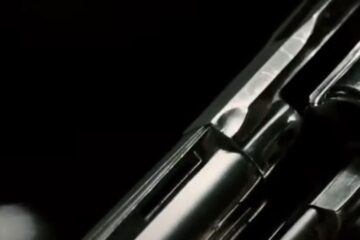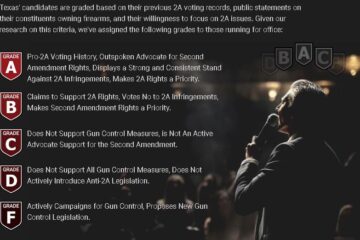Power Pair: FN 509C and 503 Review
Fabrique Nationale (FN) was once synonymous with small, high-quality concealable pistols. At the dawn of the 20th century, FN was a major player in the formative semi-automatic carry pistol market and was the European benefactor of John M. Browning’s design genius.
The FN 1900 was the debut vehicle for the .32 ACP cartridge and Browning’s patent for the enclosed slide. The little .32 was an immediate hit, and an ornate Model 1900 was associated with none other than Theodore Roosevelt as his bedside gun.
The Browning-designed Model 1910 was a refined and concealable .380 ACP, which was even more popular, particularly across Europe, and introduced a number of features that were copied on numerous pistols afterward. So, from a long view of the brand, it has been an anomaly for FN to have been largely absent from the contemporary concealed carry market.
- Activate Your Own Stem Cells & Reverse The Aging Process - Choose "Select & Save" OR Join, Brand Partner & Select Silver To Get Wholesale Prices
- Get your Vitamin B17 & Get 10% Off With Promo Code TIM
- How To Protect Yourself From 5G, EMF & RF Radiation
- Protect Your Income & Retirement Assets With Gold & Silver
- Grab This Bucket Of Heirloom Seeds & Get Free Shipping With Promo Code TIM
- Here’s A Way You Can Stockpile Food For The Future
- Stockpile Your Ammo & Save $15 On Your First Order
- Preparing Also Means Detoxifying – Here’s One Simple Way To Detoxify
The 509 Midsize introduced last year began to rectify that, and, now, the introduction of two new models targets two of the most popular segments within the carry market: the full-featured compact and the single-stack micro-compact.
The 509C miniaturizes the proven 509 platform while retaining all its features in a 12-round-capacity carry pistol chambered in 9 mm Luger. The 503 is a new entry that borrows cues and the bloodline of the 509s to compete in the slimline 9 mm category.
FN 509C
Looking at the 509C it is pretty easy to imagine the design parameters that the brass gave to the engineering team: “Reduce the 509 as much as possible while keeping it shootable and compatible with all of the major white lights and red-dot optics.” The little pistol flirts at the margins of what’s considered “compact” and “subcompact,” as the terms are commonly used.
The 509 Compact is just big enough to retain rail space for the predominant Surefire and Streamlight weapon lights. This is somewhat uncommon across platforms in this size class, with many requiring smaller and less capable lights to adapt to shorter accessory rail space.
The compact uses the same optic-mounting system that made its debut on the 509 Tactical, incorporating several plates that allow the majority of common optics to thread through the polymer riser cover and fasten directly from the optic into the slide itself.
The bulk of the recoil is absorbed onto a common “puzzle piece” plate separate from the riser that is tensioned by a small O-ring and has its own recoil lug. It is a slick arrangement that keeps the optics snug and protected. There is a cover plate for those shooters who simply want to use the robust, suppressor-height iron sights in the traditional manner, but the FN is one of the few factory-optics-ready platforms in its size bracket.
The now-common slide-mounted-optic concept was an FN innovation that launched with the FNP 45 for the defunct military Joint Combat Pistol program trials. FN feels like it had the advantage with the optic mounting and has moved into more or less the third generation of solutions, wherein the bulk of the market is still on “first generation”- style adapter plates. FN has patents covering the mounting system, and it is well-designed and robust.

During the course of a media launch event for the pistols, a dozen or so compacts were outfitted with Trijicon RMRs and SROs, Holosuns, and the new Aimpoint Acro P-1. Each mounted simply and made it through a heavy shooting day with no loosening of screws or mount-related issues. Loosening screws and mounting issues are one of the primary drawbacks to pistol-mounted miniature red-dot sights (MRDS in military parlance), and FN has a standout arrangement.
FN arranged a day and night shoot for a group of writers centered on application of the pistol-mounted optic so we could experience the 509C as a purpose-built compact optic platform. The optic offsets the short sight radius of the 3.7″ barrel and allows the compact to hit out of proportion to its size. I’ve previously seen some of the shooters at the launch event on other pistol platforms and, across the board, the firing line performed a little beyond what I might have expected from such a small pistol.
The optics were certainly a big part of the magic in the quality of shooting I saw, but there is more at play. The compact is just big enough to get all three fingers on the frontstrap, both with the baseplate extension of the 12-round magazine and with the grip extension on the included 15-round magazine.
With the 12-rounder in place, the grip feels like a well-executed “roundbutt” that allows more control than most of the competition. The feel with the extended 15-round magazine is quite similar to that of the 509 Midsize. I found the combination of shape and texture of the 509C’s grip to be both comfortable and secure, leaving my XL-glove-size hands absolutely no extra room while being “just enough” in every respect.
The “system weight” of the 509C with ACRO and affixed Streamlight TLR7A with 12-plus-one rounds of 147-gr. 9 mm is a very manageable 35 ozs. This is just light enough to be carry-friendly but heavy enough to steady the pistol against difficult shots and assist in dampening recoil. Compare that to the iconic Browning High Power, which is 38 ozs. with its 13-plus-one payload onboard.
FN seems to have made progress with the triggers on the 509 Compacts. The test pistol had the best 509-series trigger I’ve handled to date, with a total weight of 5 lbs., 10 ozs., split between some weighted take-up and a distinct break at the midpoint of 3 lbs., 12 ozs. The trigger shoe has a flat face hinged at the middle as a safety.
The 509C handles recoil well, being just slightly more brisk than the fullsize 509 Tactical. The well-designed, abbreviated grip seemed to resist some of the twisting and shifting in recoil that can affect some smaller designs. Between this, the sharp, clear dot on the Aimpoint and the better trigger, and the compact was “punching above its weight class” in a wide variety of defensive and skill-building shooting drills.
Up close at several paces, it was too easy to rattle off shots into a credit-card-size group as fast as the trigger could be worked and without letting the pistol ever come to a stop. From a ready position at 10 yds. against an MGM Targets plate rack, the compact dominoed all six plates at just a flicker over 2 seconds—faster than my average for stock, fullsize, iron-sighted striker-fired pistols.
I stretched out the compact in a couple of different ways to see what it could do. Shooting on a Wilson Combat scoreable reduced steel silhouette, I recorded the time to draw and fire a single hit into the 5.5″ square head box from 25 yds. The little pistol drew easily, and the rectangular tube of the ACRO helped guide the dot right where I needed it, allowing hits that ranged from 1.9 seconds to an average of 2.25. I later backed off to a full 70 yds. and was able to hold a respectable group on the 12″x21″ silhouette.
Prior to the 509, the classic High Power was the pistol most shooters associated with FN. I have a Belgian-made Browning Mk III that my wife gave me as a gift on my first Father’s Day after our oldest daughter was born: a special gun from some very special ladies.
It has had some light customizing but is a pretty representative sample. As I was shooting the 509C I thought it would be interesting to put it head-to-head with the High Power to see if the Aimpoint-equipped compact could hold its own against a fullsize service pistol known to be easy to shoot well.
First, I ran the plate rack at 10 yds., and the 509C was consistently faster by nearly a quarter second over the Browning, confirming my sense of how well the little compact was handling recoil. Afterward, I set the Wilson Combat steel silhouette up at 40 yds. and fired pairs from the ready for time.
Forty yards at speed is a somewhat difficult shot, so I thought it would highlight both the quality of the trigger break and the recoil recovery characteristics. The modern compact again beat the iconic single-action automatic, the ACRO allowing me to clearly place the dot and see the quality of my trigger press in the dot’s movement. The 509C ranged from 1.60 to an average of 1.75 seconds for the pair of shots while the High Power was a reaction time behind at 2.08 on average.
The 509 series has a number of strengths that translate down to the compact. One of these is the well-laid-out bilateral controls. The magazine and slide releases are equally accessible to right- and left-handed shooters, and most shooters will find the placement and function of the controls to be convenient and thoughtful.
There shouldn’t be much of an aftermarket for replacement 509 control parts, as those supplied are quite good. This is helpful, as reloading any compact pistol where the grip doesn’t extend below the bottom of the grasped firing hand can be somewhat awkward. The 509C minimizes this through effective texturing.
Another strength of the 509 family is interchangeability. Any 509 series frame is able to mate to any size slide and barrel unit, allowing shooters to mix and match. For example, I swapped the fullsize 509 Tactical frame onto the Compact top end and the longer, threaded-barrel Tactical top end onto the Compact, and function fired both. The hybrids worked fine, and I actually rather liked the longer tactical slide on the compact frame.

The gun exhibited no failures of any kind in just under 900 rounds of firing mixed brands, pressures, bullet weights and profiles of ammunition. After testing was completed, the pistol encountered a problem during dry-firing—the striker would no longer reset. The gun went back to FN, and its engineers determined it was due to excessive dry firing—which I admittedly do—without a snap cap. While detailed in the manual, potential buyers need to be aware of it.


FN 503
The 503 is FN’s entry into the single-stack micro-compact market. It is a slim, striker-fired pistol that measures only 0.9″ across the frame and carries six- or eight-plus-one rounds of 9 mm Luger onboard depending on the choice of magazine. It should appeal to shooters who want a small, but still reasonably powerful, pistol for pocket, ankle or unobtrusive belt carry.
The 503 has a distinct appearance with lines that take some time to appreciate. This is perhaps due to the grip shape, which is quite long front-to-back, while remarkably thin side-to-side. But after shooting the 503, I believe that function drove form on this point.
Getting a solid grasp on a pistol this thin can be a chore, and leads, in some models, to the pistol twisting under recoil. The almost cartoonishly “flattened” grip on the 503 gives solid front-to-back contact that better locks the pistol in the hand, allowing it to track consistently from shot to shot with very little twisting.
With the six-round magazine in place, medium-handed shooters will find the 503 to require a “two-finger” firing grip, with the little finger curled under the magazine baseplate. The included eight-round magazine extends the grip into a full, comfortable, three-finger firing grip.
The 503 trigger is a curved, thin blade with the trigger safety projecting from the middle in the now-familiar manner. The trigger moves along a long arc, minimally weighted take-up yielding to a long rolling release over about 1/3″ for a total weight of just more than 5 lbs. The feel is less typical “striker” and more very light “double-action.” To many shooters, particularly those coming from single-action semi-automatics, the description I just gave or the initial dry-fire of the system may be uninspiring, but I found the trigger to be rather easy to hit with in actual use.

The single-stack FN grouped well at 25 yds., with Black Hills’ 115-gr. Tac XPs averaging an impressive 1.83″ across five groups. The sights are drift-adjustable, low-profile steel units with a three-dot arrangement, which were well-regulated and provided a usable sight picture.
When Jack Wilson stopped the killer in the West Freeway, Texas, church with a single shot across the sanctuary, it forced a new standard into the off-duty and concealed carry world. With a truly admirable display of skill under pressure, Wilson drew his pistol and stopped the threat at about 15 yds. in fewer than five seconds from the killer’s first shot.
Many shooters saw that dramatic security camera footage and perhaps reflected with a degree of trepidation as to whether their little snubbie or pocket pistol would be up to such a challenge. The 503 is a likely candidate for such a protective role, so I set up the Wilson Combat silhouette at 15 yds. and drew from the waistband to time hits to the 4″ center circle. With the luxury of no stress and nothing but data riding on the results, I was able to stack hits in as few as two seconds and about 2.5 on average.
For a sense of how the 503 might compare in more typical close-range use, I shot it on the 5-yd. Roundup; four strings of fire each on a 2.5-second time limit including a draw, four shots from the ready, three from strong hand only, and two shots fired support hand only. The 503 passed with time to spare and full points.
To really stretch out the little single-stack, I backed off 40 yds. from the plate rack and fired a series of five-shot strings. When I did my part, it was possible to ring the steel with all five shots, with some four out of five attempts with a single “airball” leaving silence in the air to confirm and shame my inattention to the shot release. There are a good many pistols and revolvers in the ankle-gun class, and even some “combat-accurate” service pistols, that I wouldn’t necessarily be able to expect four or five hits on an 8″ plate that far out. The 503 is highly shootable.
I found the slide on the 503 easy to manipulate, something that can require attentive effort or be downright difficult in some models in this size class. The high-quality, stainless-steel magazines, however, were a test of my patience and resolve. I have never fired a pistol whose magazines were so difficult to fill—503 users will definitely benefit from some type of loading tool to assist in refilling magazines for any range sessions. The two on my test pistol could make a preacher cuss in short order.

Both the 509C and 503 are worthy entries into their segments of the concealed carry market. The 509 Compact with its “full feature and not a millimeter more” approach gives the shooter a lot of capability in a very nearly subcompact package.
The 503’s thinness and overall shootability commend it for consideration as a multi-role hideout for shooters who want a capable little pistol that can work on the ankle, large pockets or in the waistband. Together, they prove that, in addition to building highly regarded service pistols, FN is also capable of competently addressing two of the most highly competitive segments of the concealed carry pistol market.















